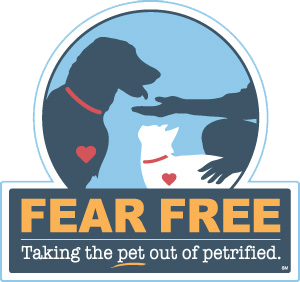Clinic Tour
Welcome to Mountainview Animal Hospital. We are very proud of our hospital and we are pleased to show it to you. We hope you enjoy the tour.

Reception Area
When you first enter our Hospital, you will be greeted by one of our receptionists. They are here to answer your questions about our pet nutrition centre, animal care supplies or begin your pet’s appointment.

Every pet is weighed on our walk on scale before their visit with the doctor. Keeping an accurate record of your pet’s weight is an important part of his or her health examination.

We always try to keep your wait time to a minimum. However, on occasion emergencies or very sick pets may cause a delay in the schedule. If you have to wait, make yourself comfortable with a glass of water from the cooler and a magazine. For the children, we have a supply of toys and books to keep them busy too.
Our public washroom is off the reception area of the hospital and it is wheel chair accessible. It is also large enough to fit the stroller for the moms and dads who bring the little ones.
Pet Food and Supplies

A large part of your pet’s good health relies on proper nutrition. Good nutrition plays a very important role in preventing serious health problems. Your veterinarian is the best source of information on the right nutrition for your pet. Our hospital carries a variety of prescription and life stage foods for your pets.
- Veterinary Medical Diets (Medical)
- Hills Prescription Diets
- Healthy Treats
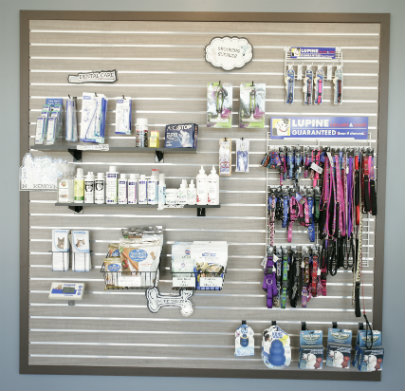
We also carry a variety of other products that we feel are important to the wellbeing of your pet
- Dental Care Supplies
- Safe and reliable flea products
- Grooming products
- Training aids—Kong, Gentle Leader, Aboi Stop
- Shampoos and Conditioners for a variety of skin conditions
Don’t forget to ask a member of our team to help you choose the best food for your pet.
Examination Rooms

Mountainview Animal Hospital has three examination rooms. These rooms are designed with benches for client to sit if they wish and are large enough for multiple family members to be present. Posters and pictures on the wall are meant to be attractive as well as informative.

Each room has an ophthalmoscope to examine the back of the eye, otoscope to examine the ears, transilluminator to illuminate the area, refrigerator for vaccine storage, enough supplies to perform most routine exam room procedures and of course plenty of treats to reward the good behavior of our furry friends. The examination tables can be flipped up out of the way to accommodate examining large dogs on the floor where they are more comfortable.

It is in the examination room where we take the time to get to know you and your pet, review your questions and concerns about your pet’s health and perform a thorough physical examination. If required we will give your pet the necessary vaccinations and perform minor tests or medical procedures. Sometimes we may wish to perform more complicated procedures; in that case your pet may visit our treatment area where we have more supplies and additional staff to assist the doctor.
Pharmacy

Just behind the examination rooms is our pharmacy. We store a variety of medications for your pets. Having a well stocked pharmacy allows us to provide you with your pet’s medication immediately. This saves you the time and inconvenience of going to an external pharmacy. It also allows you to start your pet’s medication right away, which in some cases is crucial.
Laboratory
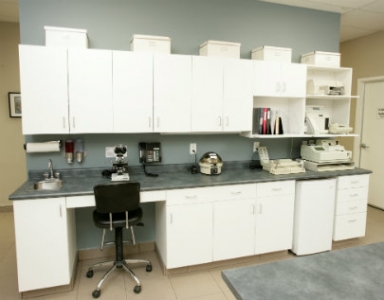
Mountainview Animal Hospital has an on-site laboratory which allows us to run many of the necessary tests which your pet may require. Our laboratory is equipped with a microscope, centrifuge, urine refractometer, QBC Vet Autoreader, Vet Test Analyser, Vetlyte Analyser, Sedivue Dx Urine Sediment Analyzer, micro-centrifuge and Snap T4 Reader.
On occasion there are tests that we cannot perform in our laboratory. Those samples are sent to an accredited outside laboratory, often still receiving results in less than 24 hours.
Radiology Room
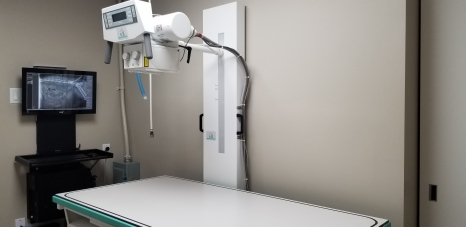
There are times when it takes a look inside the body to assess a pet’s health. X-rays allow us to look at more than just the bones; we can also view the shape, size and clarity of the body’s organs. Sometimes we can also see objects that don’t belong in the body, like golf balls, sewing needles and belt buckles.
Our x-ray machine is the latest in digital technology. This allows us to take and view the results on a computer screen almost immediately. We can also email the x-rays to a specialist when necessary for a second opinion or if your pet is being referred for a specialty surgery.
X-ray rooms are specially licensed and regularly inspected by the government for accuracy and safety. When taking X-rays our technician and animal attendants must wear protective lead gowns, thyroid collars and gloves to protect them from receiving too much radiation. They must also wear a dosimeter badge to measure and keep a record of any radiation they may have been exposed to.
Dental Area
We perform dental procedures in this area.

The ultrasonic scaler removes the rock hard tartar from the teeth. Then the technician uses hand scaling instruments to remove the finer particles of tartar below the gum line. Once the teeth are cleaned, they are polished using the low speed polisher. The water and air jets are used to rinse the mouth. Having finished her job the technician hands off the reins to the veterinarian.

Every patient has full mouth dental x-rays performed and these are carefully reviewed while the mouth is examined to determine the health of each and every tooth. to examine the teeth. Devitalized teeth are extracted using elevators and sometimes the high speed dental drill.
We will also perform minor oral surgery when necessary.
Surgical Preparation Room

Before our doctors perform surgery on your pet, they must prepare themselves in a sterile manner. A special sink allows the surgeon to scrub her hands and arms without touching a faucet. After carefully and thoroughly scrubbing with special surgical soap, the surgeon must dress in a cap, mask, and sterile gown and gloves. Hand towels, gowns and surgical instruments are steam sterilized in our autoclave. All this occurs in a separate room called the surgical preparation room, away from the busyness of the rest of the clinic.
Surgical Suite

It is in this room that your pet’s surgeries are performed. Our anesthetic machine delivers a gas anesthetic and oxygen in precisely measured amounts to keep your pet safely anesthetized through the surgery. All pets are monitored for body temperature, gum colour, heart rate and rhythm, breathing pattern, depth of anesthesia and hydration status by our Registered Veterinary Technician.
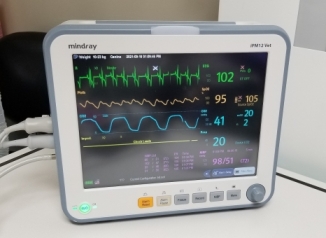
Our digital monitor runs a constant electrocardiogram (ECG), measures blood oxygen levels, end tidal CO2 levels, and blood pressure. It alarms us if either measurement climbs above or falls below preset safety parameters. All of this monitoring ensures we are doing everything we can to keep your pet safe during his or her anesthesia.
Treatment Area

This large room is the central hub of the hospital. This is where we examine hospitalized patients and perform most medical procedures. The speciality light over the treatment island illuminates the tiniest slivers, ulcers and ingrown hair.

Observation Kennels

The kennels at the back of the treatment room are in full vision of our laboratory, surgical suite and doctor’s office so that patients in these kennels are under constant supervision. This is where we house the sick patients and pets recovering from surgery. Above these kennels is an oxygen hose. This hose can be connected to a nasal oxygen line to deliver moisturized oxygen directly into the nose of an animal in respiratory distress. Dehydrated patients require intravenous fluids. The amount of fluid we deliver to a patient can be precisely controlled by using an intravenous fluid pump.
Doctor’s Station

This work station allows the doctors to sit, write records, and make telephone calls to clients, all while having a full view of the observation kennels and the treatment area.
Kitchen & Feeding Station

The kitchen is located off the treatment area and patient kennel rooms. It is here that we store and prepare the pet’s foods.
We have a variety of diet formulations to choose from to treat our sick patients. For those animals that are here boarding, we usually recommend that clients bring their pet’s food from home so there is as little change as possible for our furry friends.
Cat Ward

This quiet room is where boarding or hospitalized (those that are not critically ill) cats stay. The walls are insulated to reduce the noise coming from the rest of the hospital. All cats get a blanket, litter box, food and water as their medical condition allows, and of course cuddle time with our staff.
Dog Ward

This kennel room is reserved for small and medium sized dogs. Blankets and comforters provide comfort and warmth. All dogs are taken outside on a double leash for a short walk 4 times per day.
Dog Runs

Medium and large sized dogs stay in our dog runs. These kennels are supersized to give more room for the bigger beasts. Space permitting, the smaller dogs get some play time in here too.
Grooming Tub

Many of our clients take advantage of the brushing and bathing services we provide for both dogs and cats. All dogs that have been boarding with us for more than 5 days are treated to a complementary bath, with their owner’s permission of course.
By raising the bathtub we avoid the back aches of bending over to bathe the smaller animals.

Not all of our patients are appreciative of this service though, just ask Tango. She has her long fur brushed, shaved and bathed 2 to 3 times per year. Although she is not thrilled with the process, she seems to enjoy her new look once she is all dry and fluffy.
Isolation Room

Any patient thought to have a contagious illness is placed in our isolation room until proven otherwise. This is not only for their own protection, but also for that of all of our hospitalized and boarded animals. Some contagious diseases are also transmissible to humans as well, so it is important to limit the human contact to only trained personnel. Fortunately, because most of your pets are well vaccinated, we rarely have patients with contagious diseases, so this room is not used very often.
Dog Walking Area

Four times a day we take all of the dogs outside for a short walk and breath of fresh air. For safety reasons, two leashes are placed on each dog.
We encourage even our hospitalized patients to go outside for a short break, weather permitting. The fresh air and change of scenery helps to brighten their spirits.
Staff Area and Storage

This room is located near the treatment area and is where the staff can eat their lunch, take a break, read a magazine, use the computer or make a personal phone call. Although their break times are supposed to be for relaxing, the staff are never far from the animals and they are always ready to lend a helping hand should we need them.
The back of the Staff Area has built in cabinets for storage
Laundry Area

At the very back of the hospital is the staff washroom and laundry area. Our laundry machine and dryer are constantly in use. Every patient of the hospital gets fresh towels and blankets at least once daily, more often if required.








